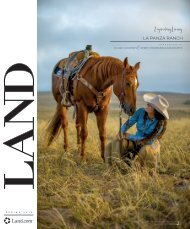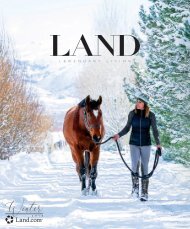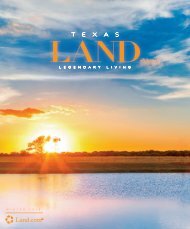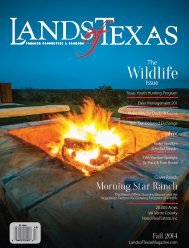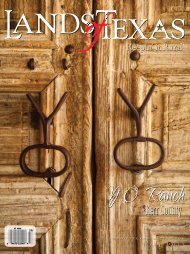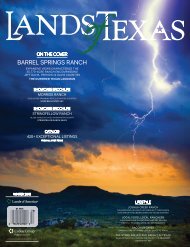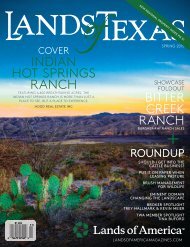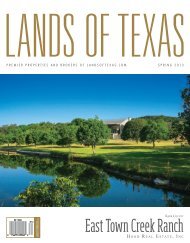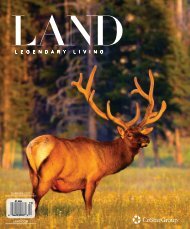Create successful ePaper yourself
Turn your PDF publications into a flip-book with our unique Google optimized e-Paper software.
SPORTING ISSUE<br />
It had been almost 30 years since my brother and I had last hunted together,<br />
which was probably the last time that he had hunted. Robby was in town for a<br />
weekend visit and our Sunday morning foray into one of our local dove fields<br />
seemed like a good ticket to catch up on some old times. “These things are like<br />
little gray ghosts in the sky,” he claimed. With over a box of spent green Remington<br />
hulls, he had only one bird to show for his efforts. “You’re just a little rusty, that’s<br />
all,” were my consoling words. I then dumped my 15 bird limit on the tailgate and<br />
spouted, “Looks like little brother won this round.” But he didn’t care, nor did I,<br />
as we were both simply enjoying the opportunity for some much-needed familial<br />
time together. And that is one of the things<br />
I like so much about dove hunting; it lends<br />
itself to various occasions of the hunt,<br />
from a solo standpoint, as well as those<br />
which involve a social component. “Okay<br />
big brother, now that I’ve schooled you on<br />
putting these little gray ghosts in the bag,<br />
I’m now going to show you how you put<br />
them on a plate,” and we did indeed enjoy<br />
a tasty pasture to plate lunch.<br />
The Bird<br />
There are seven species of indigenous<br />
doves and pigeons in <strong>Texas</strong>, with whitewinged<br />
doves and mourning doves<br />
being the two species that are the most<br />
abundant and are most commonly<br />
hunted. Though the white-tipped dove<br />
is considered a gamebird in <strong>Texas</strong>, very<br />
little hunting for this dove takes place due<br />
to lack of opportunity that’s presented by<br />
the birds’ scarcity and lack of distribution.<br />
Inca doves, common ground doves, band-tailed pigeons, and red-billed pigeons<br />
round out the lot, but are non-factors in the <strong>Texas</strong> hunting scene.<br />
Mourning doves are the most ubiquitous of the North American dove species,<br />
being found in all lower 48 states, as well as in Canada, Mexico, and Central America.<br />
It’s been estimated that our <strong>Texas</strong> fall mourning dove populations are upwards of<br />
50 million birds. These grain-eaters have broad habitat tolerances and are perfectly<br />
content making their homes in the back yards our largest of metro locales, as well<br />
as the wilds of <strong>Texas</strong>’ back forty.<br />
White-winged dove are a bit newer on the scene in much of <strong>Texas</strong>. Historically, the<br />
lion’s share of whitewings in <strong>Texas</strong> were found in the Lower Rio Grande Valley Region<br />
of deep South <strong>Texas</strong>. However, this largely began changing some 20–25 years ago,<br />
as these birds began showing up in locales further north in the state. Recent years<br />
have seen whitewings scattered over much of <strong>Texas</strong>, including the northern reaches<br />
of the state, but it’s interesting to note that the resident concentration of whitewings<br />
in many areas of <strong>Texas</strong> are highly centered in and around urban areas.<br />
Referred to some as the “bonus bird,” Eurasian collared doves, or ringnecks<br />
as they are often called, are an exotic species with numbers and distribution<br />
that has greatly grown over the last 10 years around the state. They are slightly<br />
larger than a whitewing, have no closed season and no bag limits, hence being<br />
referred to as a bonus bird. Interestingly, they tend to be predictably site-specific,<br />
A classic set-up with hunter using grain<br />
stubble to break their outline, with<br />
decoy out front. (above)<br />
Recruitment of young and new hunters<br />
into hunting is part of the recipe for<br />
ensuring the future health of our<br />
important hunting heritage. (left)<br />
<strong>LAND</strong>.COM • LEGENDARY LIVING<br />
157





